Fuel TOYOTA GT86 2017 1.G Owners Manual
[x] Cancel search | Manufacturer: TOYOTA, Model Year: 2017, Model line: GT86, Model: TOYOTA GT86 2017 1.GPages: 428, PDF Size: 7.83 MB
Page 2 of 428
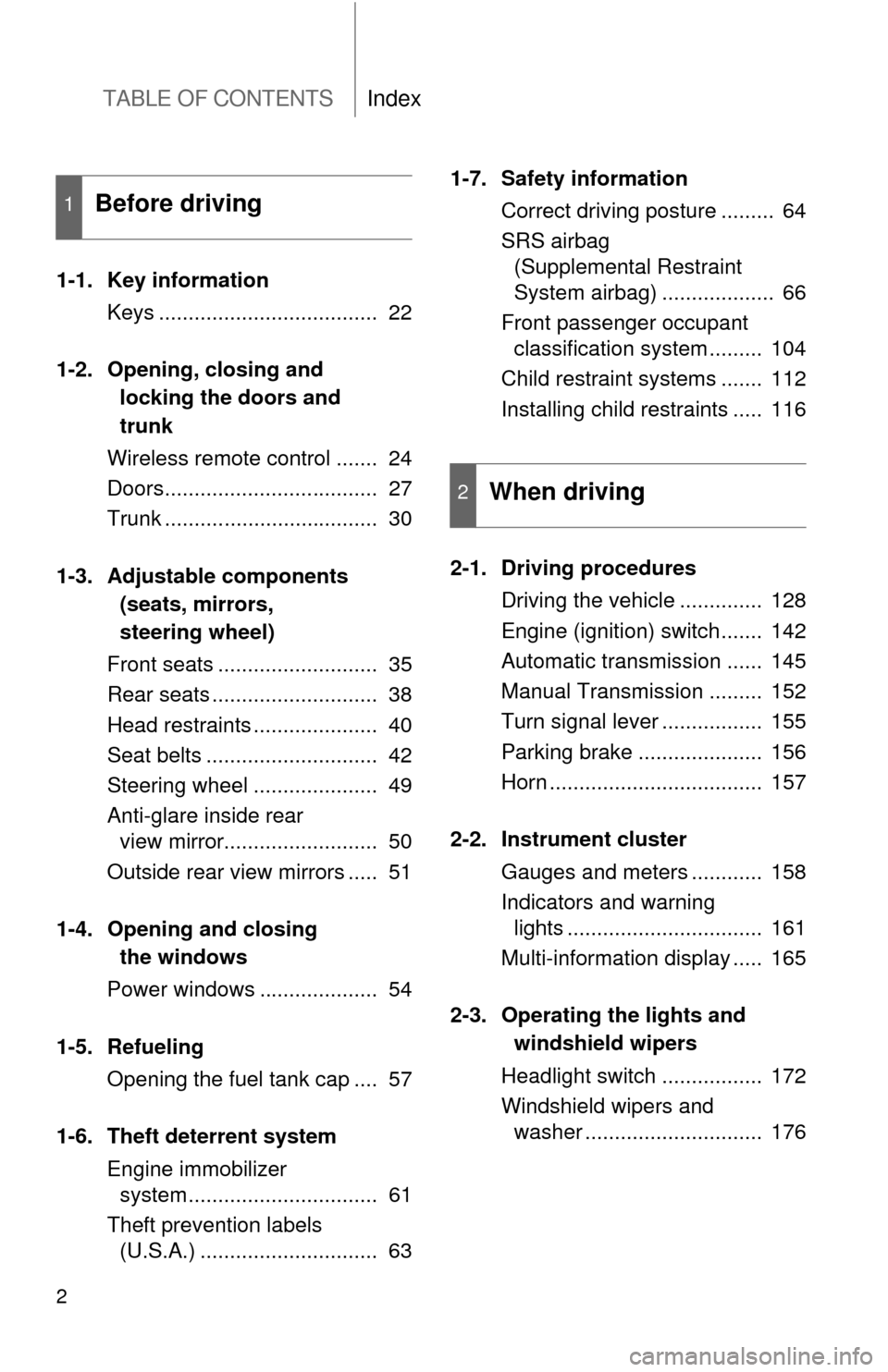
TABLE OF CONTENTSIndex
2
1-1. Key informationKeys ..................................... 22
1-2. Opening, closing and locking the doors and
trunk
Wireless remote control ....... 24
Doors.................................... 27
Trunk .................................... 30
1-3. Adjustable components (seats, mirrors,
steering wheel)
Front seats ........................... 35
Rear seats ............................ 38
Head restraints ..................... 40
Seat belts ............................. 42
Steering wheel ..................... 49
Anti-glare inside rear view mirror.......................... 50
Outside rear view mirrors ..... 51
1-4. Opening and closing the windows
Power windows .................... 54
1-5. Refueling Opening the fuel tank cap .... 57
1-6. Theft deterrent system Engine immobilizer system ................................ 61
Theft prevention labels (U.S.A.) .............................. 63 1-7. Safety information
Correct driving posture ......... 64
SRS airbag (Supplemental Restraint
System airbag) ................... 66
Front passenger occupant classification system ......... 104
Child restraint systems ....... 112
Installing child restraints ..... 116
2-1. Driving procedures Driving the vehicle .............. 128
Engine (ignition) switch....... 142
Automatic transmission ...... 145
Manual Transmission ......... 152
Turn signal lever ................. 155
Parking brake ..................... 156
Horn .................................... 157
2-2. Instrument cluster Gauges and meters ............ 158
Indicators and warning lights ................................. 161
Multi-information display ..... 165
2-3. Operating the lights and windshield wipers
Headlight switch ................. 172
Windshield wipers and washer .............................. 176
1Before driving
2When driving
Page 4 of 428
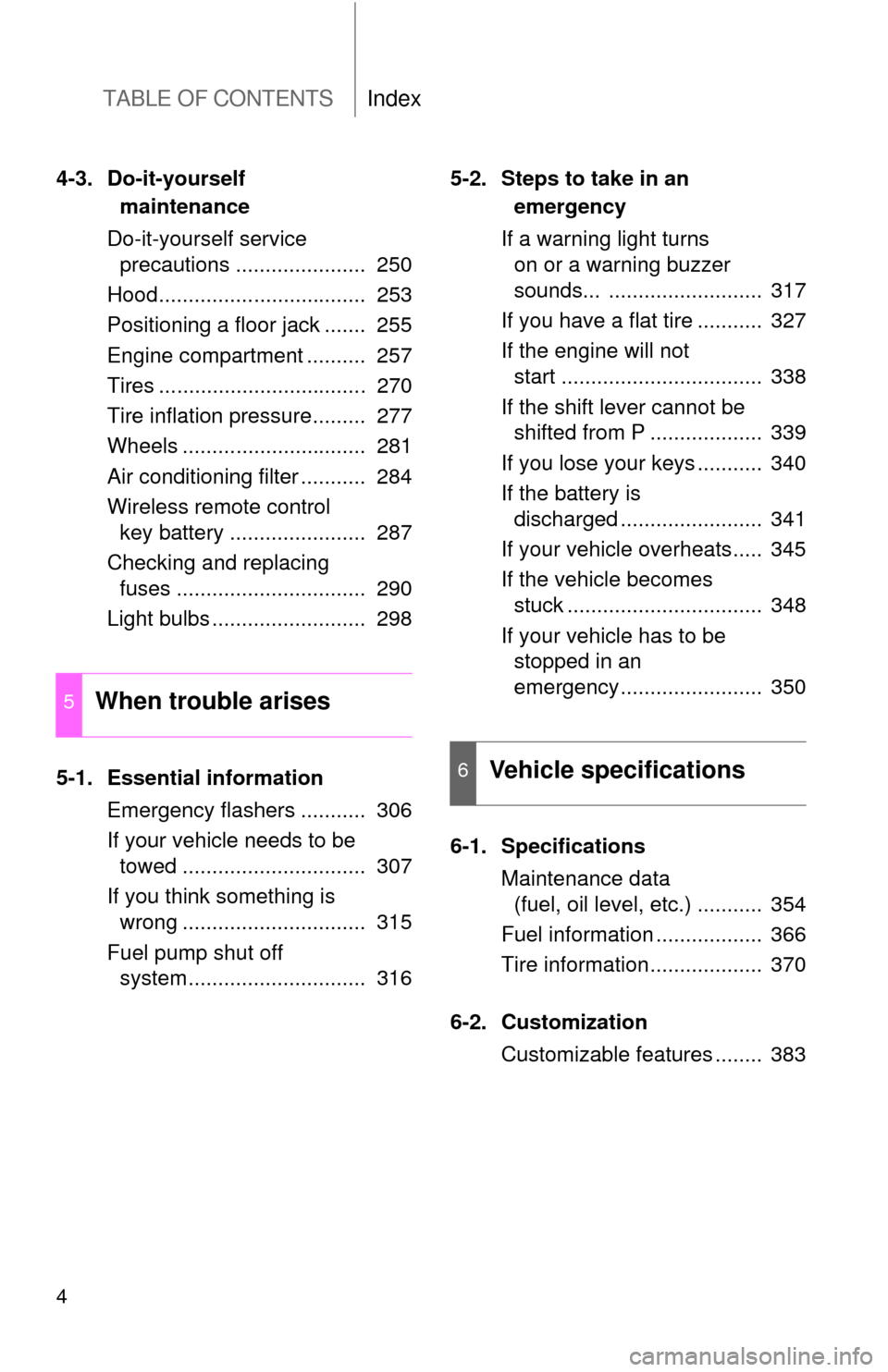
TABLE OF CONTENTSIndex
4
4-3. Do-it-yourself maintenance
Do-it-yourself service precautions ...................... 250
Hood................................... 253
Positioning a floor jack ....... 255
Engine compartment .......... 257
Tires ................................... 270
Tire inflation pressure......... 277
Wheels ............................... 281
Air conditioning filter ........... 284
Wireless remote control key battery ....................... 287
Checking and replacing fuses ................................ 290
Light bulbs .......................... 298
5-1. Essential information Emergency flashers ........... 306
If your vehicle needs to be towed ............................... 307
If you think something is wrong ............................... 315
Fuel pump shut off system .............................. 316 5-2. Steps to take in an
emergency
If a warning light turns on or a warning buzzer
sounds... .......................... 317
If you have a flat tire ........... 327
If the engine will not start .................................. 338
If the shift lever cannot be shifted from P ................... 339
If you lose your keys ........... 340
If the battery is discharged ........................ 341
If your vehicle overheats..... 345
If the vehicle becomes stuck ................................. 348
If your vehicle has to be stopped in an
emergency........................ 350
6-1. Specifications Maintenance data (fuel, oil level, etc.) ........... 354
Fuel information .................. 366
Tire information................... 370
6-2. Customization Customizable features ........ 383
5When trouble arises
6Vehicle specifications
Page 7 of 428
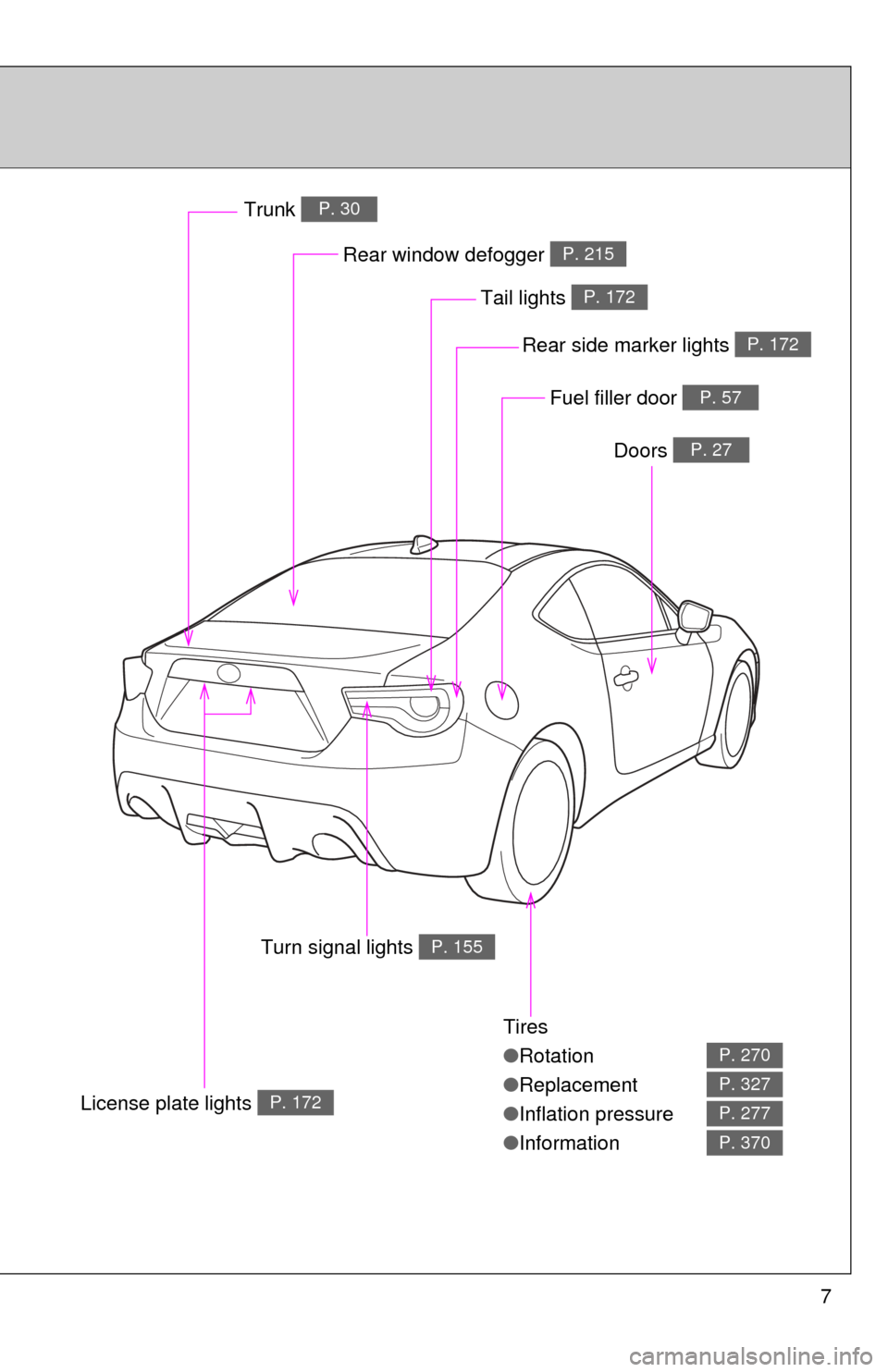
7
Tires
●Rotation
● Replacement
● Inflation pressure
● Information
P. 270
P. 327
P. 277
P. 370
Rear window defogger P. 215
Trunk P. 30
Doors P. 27
Fuel filler door P. 57
Tail lights P. 172
Rear side marker lights P. 172
License plate lights P. 172
Turn signal lights P. 155
Page 11 of 428
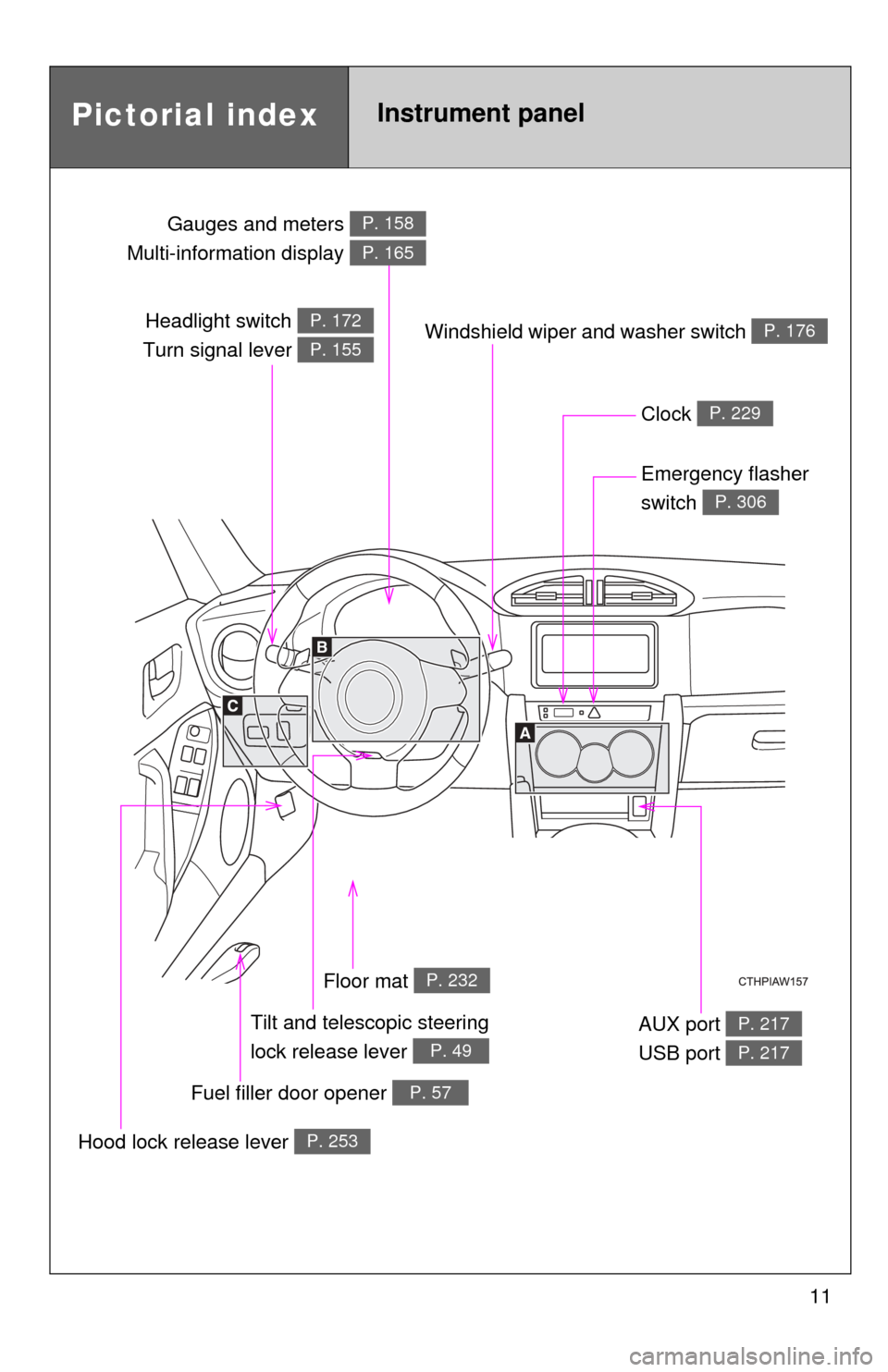
11
Headlight switch
Turn signal lever P. 172
P. 155
Gauges and meters
Multi-information display P. 158
P. 165
Clock P. 229
Windshield wiper and washer switch P. 176
Emergency flasher
switch
P. 306
Tilt and telescopic steering
lock release lever
P. 49
Floor mat P. 232
Hood lock release lever P. 253
Fuel filler door opener P. 57
AUX port
USB port P. 217
P. 217
Pictorial indexInstrument panel
Page 15 of 428

15
For your information
Main Owner’s Manual
Please note that this manual applies to all models and explains all equip-
ment, including options. Therefore, you may find some explanations for
equipment not installed on your vehicle.
All specifications provided in this manual are current at the time of printing.
However, because of the Toyota policy of continual product improvement, we
reserve the right to make changes at any time without notice.
Depending on specifications, the vehicle shown in the illustration may differ
from your vehicle in terms of color and equipment.
Noise from under vehicle after turning off the engine
Approximately five to ten hours after the engine is turned off, you may hear
sound coming from under the vehicle for several minutes. This is the sound
of a fuel evaporation leakage check and, it does not indicate a malfunct\
ion.
Accessories, spare parts and modification of your Toyota
A wide variety of non-genuine spare parts and accessories for Toyota vehi-
cles are currently available in the market. You should know that Toyota does
not warrant these products and is not responsible for their performance,
repair, or replacement, or for any damage they may cause to, or adverse
effect they may have on, your Toyota vehicle.
This vehicle should not be modified with non-genuine Toyota products. Mod-
ification with non-genuine Toyota products could affect its performance,
safety or durability, and may even violate governmental regulations. In addi-
tion, damage or performance problems resulting from the modification may
not be covered under warranty.
Page 16 of 428

16
Installation of a mobile two-way radio system
The installation of a mobile two-way radio system in your vehicle could affect
electronic systems such as:
● Multiport fuel injection system/sequential multiport fuel injection system
● Cruise control system
● Anti-lock brake system
● SRS airbag system
● Seat belt pretensioner system
Be sure to check with your Toyota dealer for precautionary measures or spe-
cial instructions regarding installation of a mobile two-way radio system.
Page 21 of 428
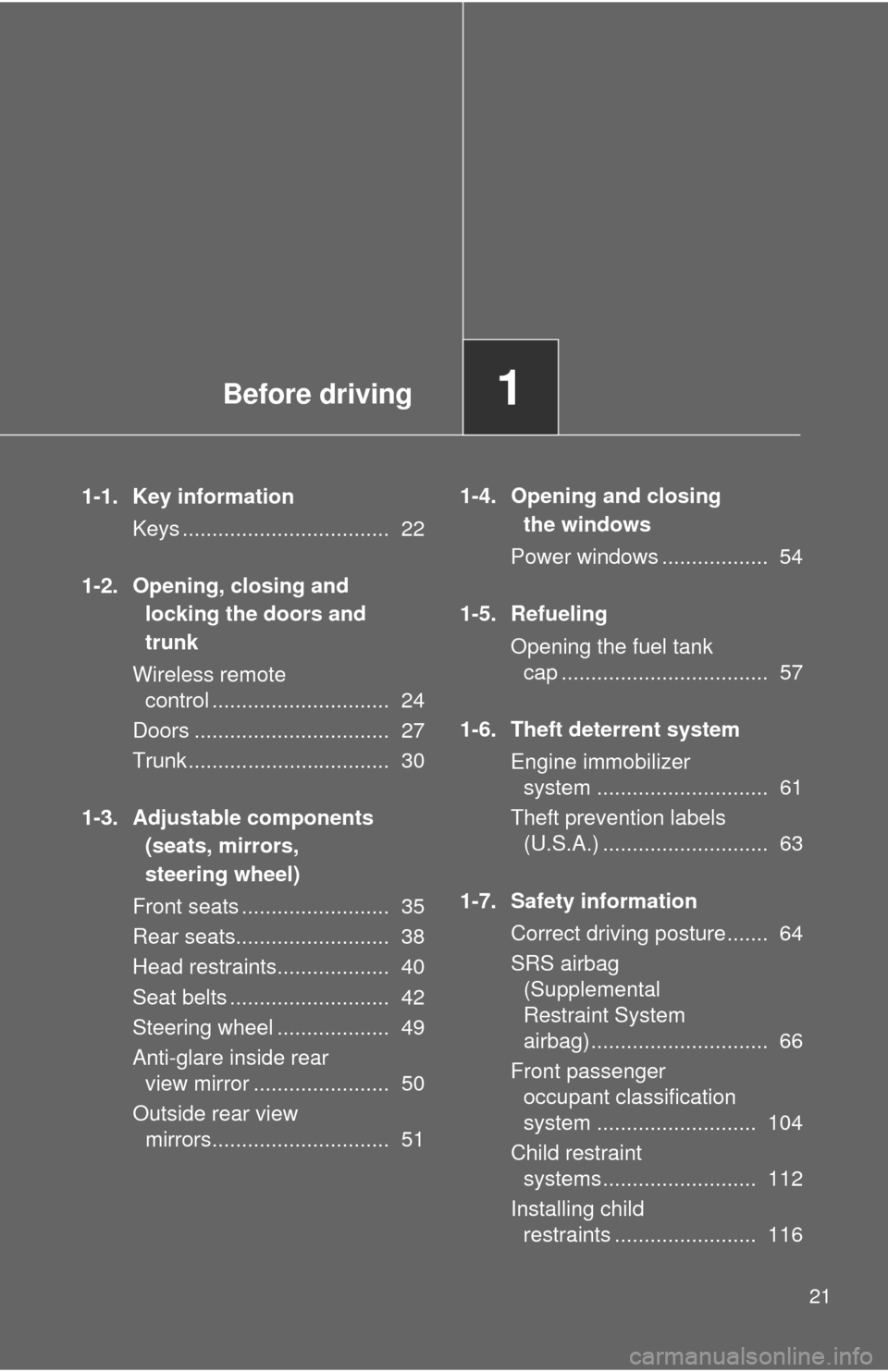
Before driving1
21
1-1. Key informationKeys ................................... 22
1-2. Opening, closing and locking the doors and
trunk
Wireless remote control .............................. 24
Doors ................................. 27
Trunk .................................. 30
1-3. Adjustable components (seats, mirrors,
steering wheel)
Front seats ......................... 35
Rear seats.......................... 38
Head restraints................... 40
Seat belts ........................... 42
Steering wheel ................... 49
Anti-glare inside rear view mirror ....................... 50
Outside rear view mirrors.............................. 51 1-4. Opening and closing
the windows
Power windows .................. 54
1-5. Refueling Opening the fuel tank cap ................................... 57
1-6. Theft deterrent system Engine immobilizer system ............................. 61
Theft prevention labels (U.S.A.) ............................ 63
1-7. Safety information Correct driving posture....... 64
SRS airbag (Supplemental
Restraint System
airbag).............................. 66
Front passenger occupant classification
system ........................... 104
Child restraint systems.......................... 112
Installing child restraints ........................ 116
Page 57 of 428
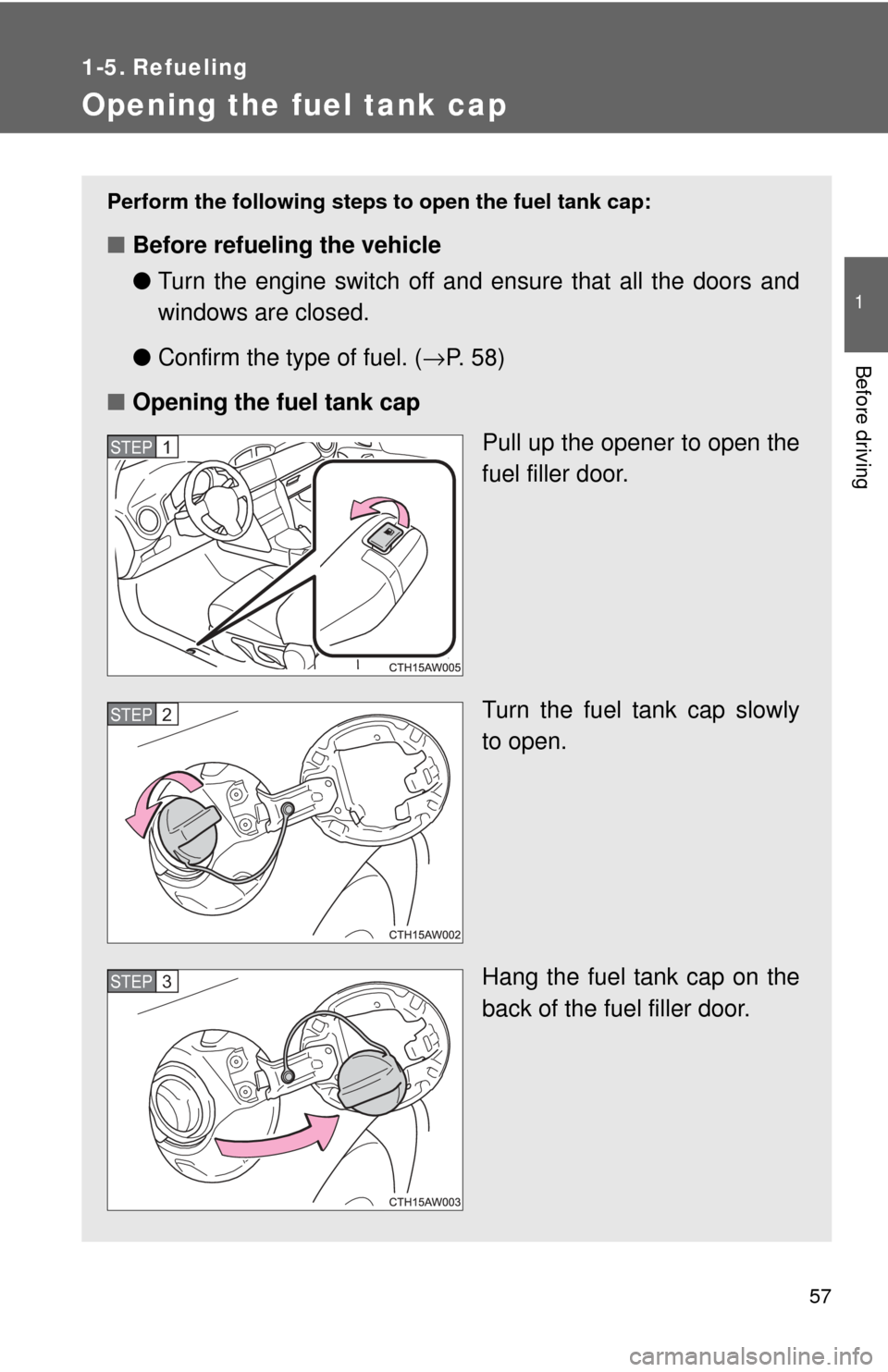
57
1
Before driving
1-5. Refueling
Opening the fuel tank cap
Perform the following steps to open the fuel tank cap:
■Before refueling the vehicle
●Turn the engine switch off and ensure that all the doors and
windows are closed.
● Confirm the type of fuel. ( →P. 5 8 )
■ Opening the fuel tank cap
Pull up the opener to open the
fuel filler door.
Turn the fuel tank cap slowly
to open.
Hang the fuel tank cap on the
back of the fuel filler door.
STEP 1
STEP 2
STEP 3
Page 58 of 428
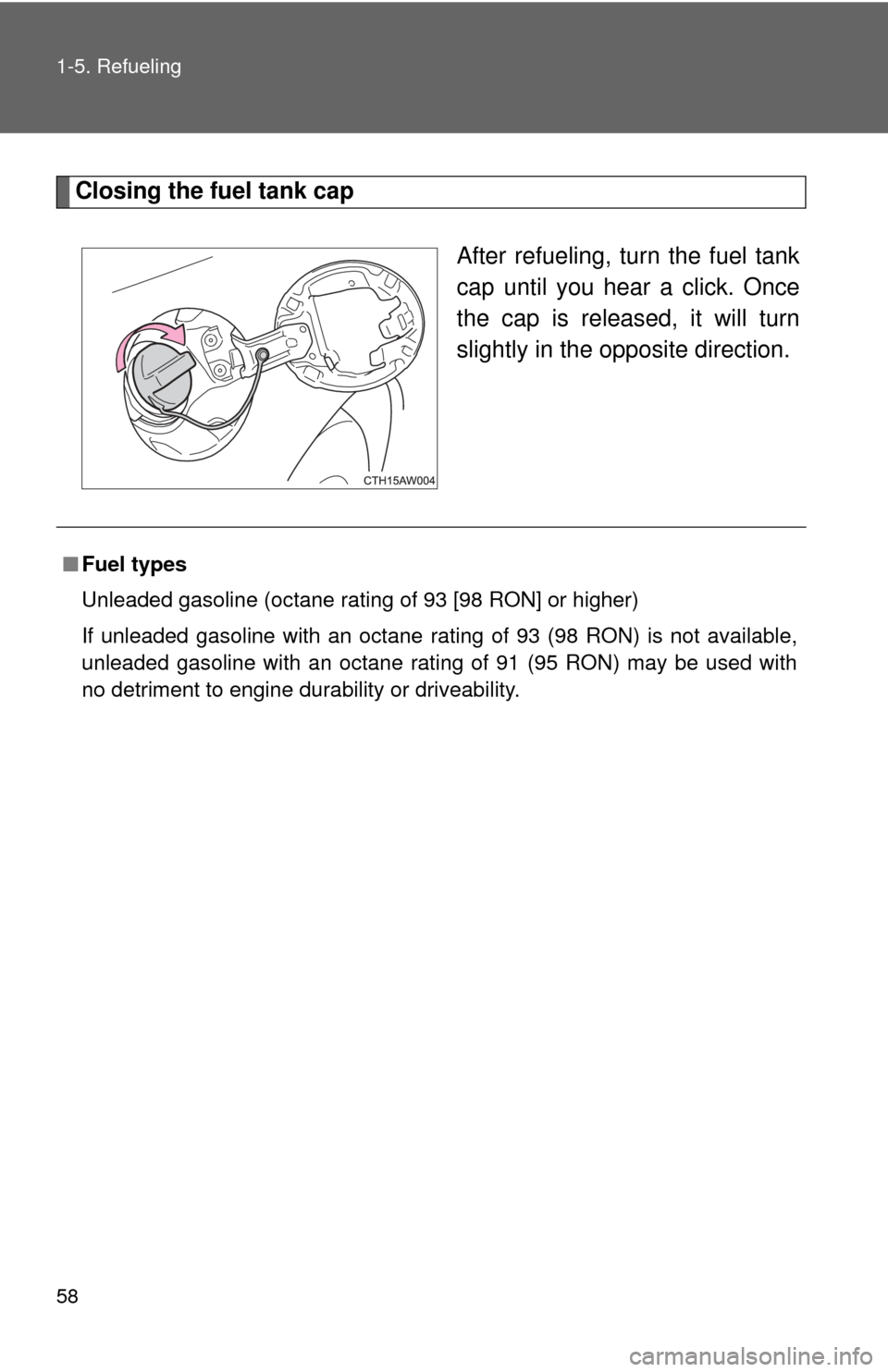
58 1-5. Refueling
Closing the fuel tank capAfter refueling, turn the fuel tank
cap until you hear a click. Once
the cap is released, it will turn
slightly in the opposite direction.
■Fuel types
Unleaded gasoline (octane rating of 93 [98 RON] or higher)
If unleaded gasoline with an octane rating of 93 (98 RON) is not available,
unleaded gasoline with an octane rating of 91 (95 RON) may be used with
no detriment to engine durability or driveability.
Page 59 of 428
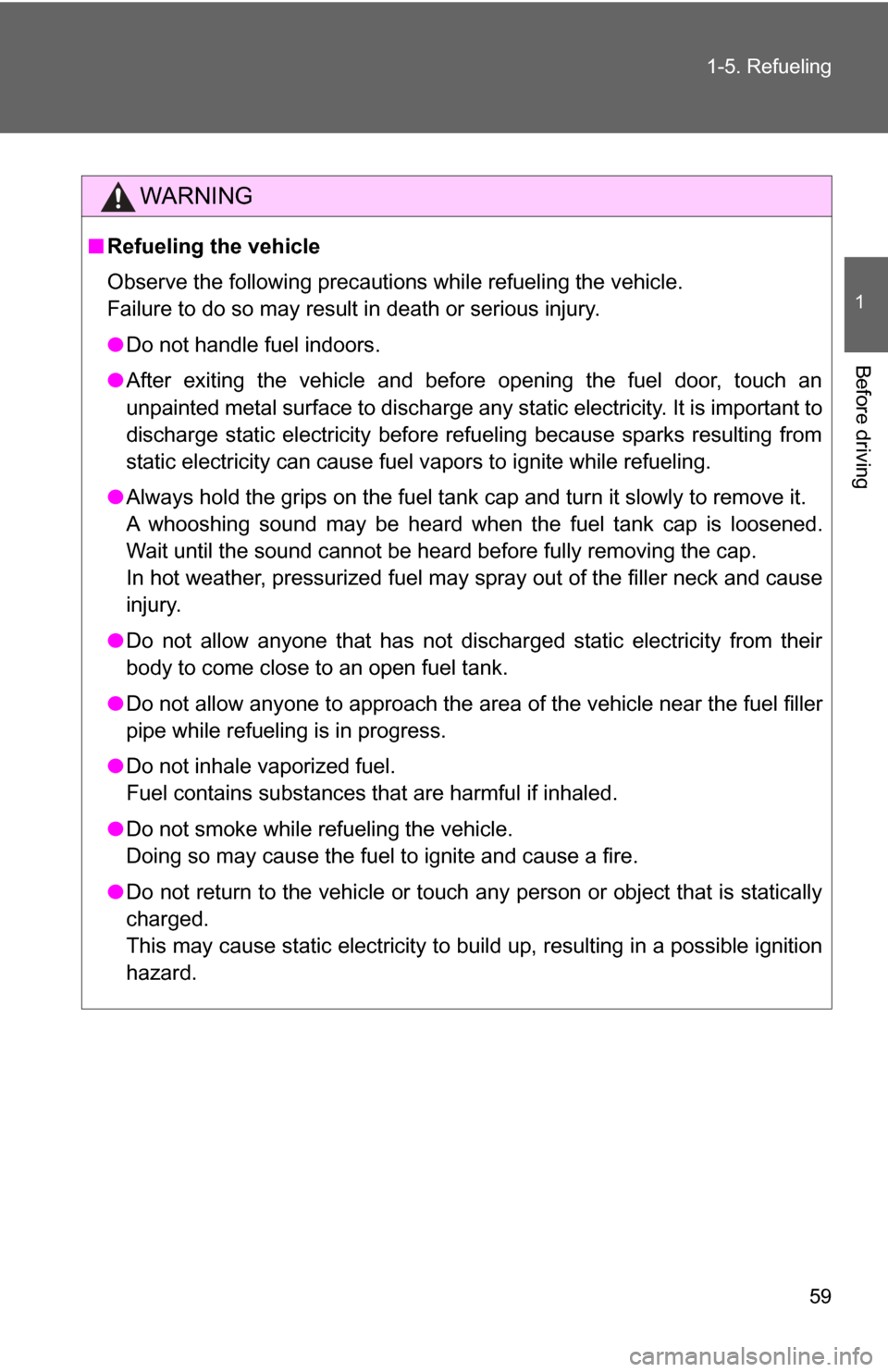
59
1-5. Refueling
1
Before driving
WARNING
■
Refueling the vehicle
Observe the following precautions while refueling the vehicle.
Failure to do so may result in death or serious injury.
●Do not handle fuel indoors.
● After exiting the vehicle and before opening the fuel door, touch an
unpainted metal surface to discharge any static electricity. It is important to
discharge static electricity before refueling because sparks resulting from
static electricity can cause fuel vapors to ignite while refueling.
● Always hold the grips on the fuel tank cap and turn it slowly to remove it.
A whooshing sound may be heard when the fuel tank cap is loosened.
Wait until the sound cannot be heard before fully removing the cap.
In hot weather, pressurized fuel may spray out of the filler neck and cause
injury.
● Do not allow anyone that has not discharged static electricity from their
body to come close to an open fuel tank.
● Do not allow anyone to approach the area of the vehicle near the fuel filler
pipe while refueling is in progress.
● Do not inhale vaporized fuel.
Fuel contains substances that are harmful if inhaled.
● Do not smoke while refueling the vehicle.
Doing so may cause the fuel to ignite and cause a fire.
● Do not return to the vehicle or touch any person or object that is statically
charged.
This may cause static electricity to build up, resulting in a possible ignition
hazard.